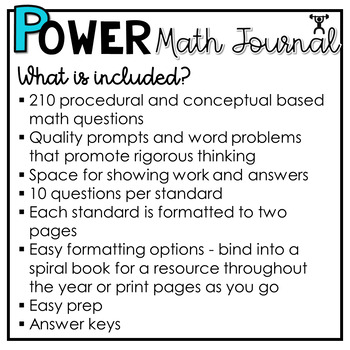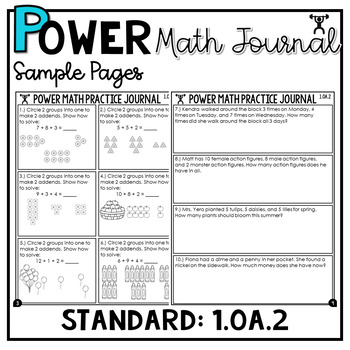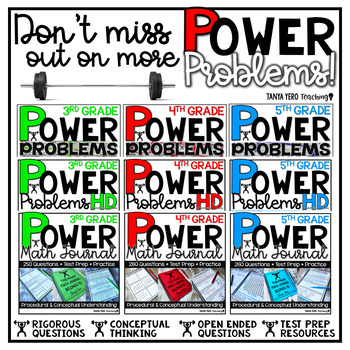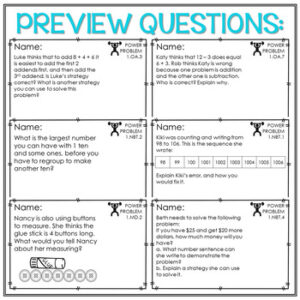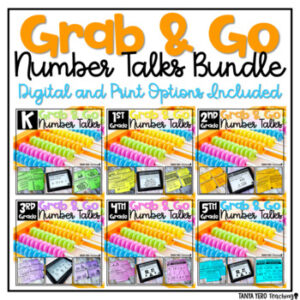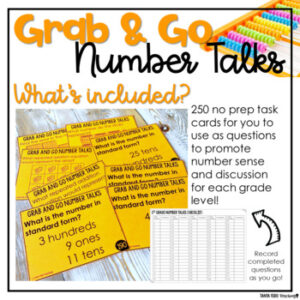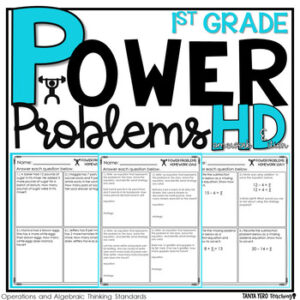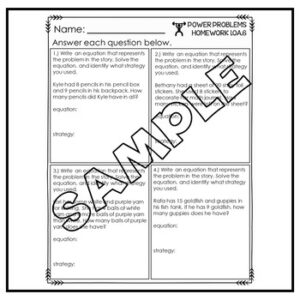Description
Add rigor and conceptual thinking to your math block with the POWER Math Journal. Designed for student practice, this journal has questions that target both procedural and conceptual understanding. You can bind the pages to make a journal or you can simply print out the pages for a print and go resource! 10 prompts/ questions are included per standard with space for work and answers. Most questions are short answer responses. You can use this math resource for test prep, math instruction, practice, or review! Answer keys are included.
What’s included in this product?
- Quality prompts and word problems that promote rigorous thinking
- Space for showing work and answers
- 10 questions per standard
- Each standard is formatted to two pages
- Easy formatting options – bind into a spiral book for a resource throughout the year or print pages as you go
- Easy prep
- Answer keys
Standards and Topics Covered
Operations and Algebraic Thinking
➥ 1.OA.1 – Use addition and subtraction within 20 to solve word problems
➥ 1.OA.2 – Solve word problems that call for addition of three whole numbers whose sum is less than or equal to 20
➥ 1.OA.3 – Apply properties of operations as strategies to add and subtract
➥ 1.OA.4 – Understand subtraction as an unknown-addend problem
➥ 1.OA.5 – Relate counting to addition and subtraction
➥ 1.OA.6 – Add and subtract within 20, demonstrating fluency for addition and subtraction within 10
➥ 1.OA.7 – Understand the meaning of the equal sign
➥ 1.OA.8 – Determine the unknown whole number in an addition or subtraction equation
Number and Operations in Base Ten
➥ 1.NBT.1 – Count to 120, starting at any number less than 120
➥ 1.NBT.2 – Understand that the two digits of a two-digit number represent amounts of tens and ones
➥ 1.NBT.3 – Compare two two-digit numbers
➥ 1.NBT.4 – Add within 100, including adding a two-digit number and a one-digit number
➥ 1.NBT.5 – Given a two-digit number, mentally find 10 more or 10 less than the number
➥ 1.NBT.6 – Subtract multiples of 10 in the range 10-90 from multiples of 10 in the range 10-90
Measurement and Data
➥ 1.MD.1 – Order objects by length
➥ 1.MD.2 – Express the length of an object as a whole number of length units, by laying multiple copies of a shorter object
➥ 1.MD.3 – Tell and write time in hours and half-hours using analog and digital clocks
➥ 1.MD.4 – Organize, represent, and interpret data with up to three categories
Geometry
➥ 1.G.1 – Identifying attributes of shapes
➥ 1.G.2 – Composing shapes
➥ 1.G.3 – Partition circles and rectangles into equal shares
This purchase contains 5 questions for each math standard in 1st grade. 105 word problems to carry you through the year!
Standards and Topics Covered
Measurement and Data
➥ 1.G.1 – Identifying attributes of shapes
➥ 1.G.2 – Composing shapes
➥ 1.G.3 – Partition circles and rectangles into equal shares
WHAT ARE POWER PROBLEMS?™
PURPOSEFUL – These problems are meant to keep students focused, while strengthening initiative and perseverance.
OPPORTUNITIES – These prompts can be used in a variety of ways. POWER Problems™ can be used to introduce a lesson, spiral review, or as formative assessments.
WITH
ENGAGEMENT – Problems are real world applicable and designed to hook students with interest and presentation. Complexity of problems promotes problem solving skills.
RIGOR – Tasks are specifically designed to challenge students and assess conceptual understanding of curriculum versus procedural understanding. Students will need to apply more than just a “formula.”
WHY USE POWER PROBLEMS?™
BUILD STAMINA WITHIN YOUR STUDENTS!
POWER Problems™ are designed to challenge your students with their open ended presentation. Majority of problems that come from textbooks and workbooks assess procedural understanding of curriculum. Some textbooks even provide step by step instructions where the textbook is thinking for the students and taking away that “productive struggle” for children. When we rob students of that event, we rob them of their ability to reason, problem solve, and see beyond a standard algorithm. POWER Problems™ are meant to show students that there are different ways to answer one question in math. With these tasks students take ownership and are part of the problem solving process versus filling in blanks in a textbook.
HOW TO USE POWER PROBLEMS™:
YOUR KIDS. YOUR CHOICE. FLEXIBILITY.
TO INTRODUCE A LESSON – POWER Problems™ can be used to introduce a new skill. In this case your students will experience a “productive struggle.” Their problem solving skills and prior knowledge will kick in. Often times most of my students will have the incorrect answer or no answer at all. I then have someone explain their method/reasoning and allow my students to critique their peer’s answer. This makes for great accountable talk discussions. If I see that most students do not have an answer I will assist the class in getting to a specific point and then allow them to finish independently.
SPIRAL REVIEW – Avoid your students forgetting standards, by using POWER Problems™ to spiral review previously taught lessons.
FORMATIVE ASSESSMENTS – You can use these problems to assess mastery and levels of understanding.



